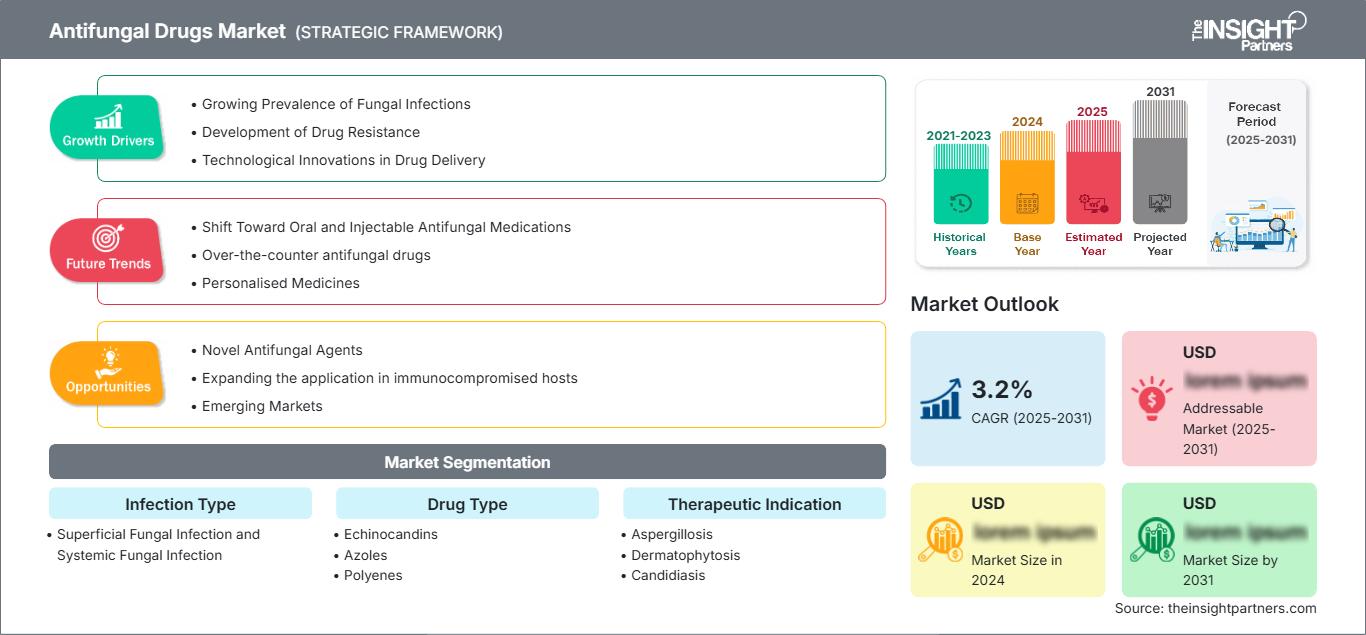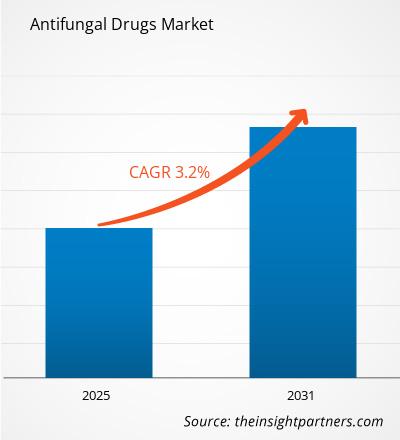Si prevede che il mercato dei farmaci antifungini raggiungerà i 21,16 miliardi di dollari entro il 2031. Si prevede che il mercato registrerà un CAGR del 4,2% nel periodo 2025-2031.
Il rapporto sul mercato dei farmaci antifungini analizza il tipo di infezione (infezione fungina superficiale e infezione fungina sistemica), il tipo di farmaco (echinocandine, azoli, polieni, allilamine e altri), l'indicazione terapeutica (aspergillosi, dermatofitosi, candidosi e altri) e la forma di dosaggio (farmaci, unguento, polvere e altri). L'analisi globale è ulteriormente suddivisa a livello regionale e per i principali paesi. Il rapporto offre il valore in USD per l'analisi e i segmenti di cui sopra.
Scopo del rapporto
Il rapporto sul mercato dei farmaci antifungini di The Insight Partners mira a descrivere il panorama attuale e la crescita futura, i principali fattori trainanti Fattori, sfide e opportunità. Ciò fornirà spunti di riflessione a vari stakeholder aziendali, come:
- Fornitori/Produttori di Tecnologia: per comprendere le dinamiche di mercato in evoluzione e conoscere le potenziali opportunità di crescita, consentendo loro di prendere decisioni strategiche informate.
- Investitori: per condurre un'analisi completa delle tendenze in merito al tasso di crescita del mercato, alle proiezioni finanziarie di mercato e alle opportunità esistenti lungo la catena del valore.
- Organismi di regolamentazione: per regolamentare le politiche e le attività di controllo sul mercato con l'obiettivo di ridurre al minimo gli abusi, preservare la fiducia degli investitori e sostenere l'integrità e la stabilità del mercato.
Segmentazione del mercato dei farmaci antifungini: tipo di infezione
- Infezione fungina superficiale e infezione fungina sistemica
Tipo di farmaco
- Echinocandine
- Azoli
- Polieni
- Allilamine
Indicazione terapeutica
- Aspergillosi
- Dermatofitosi
- Candidosi
- Altri
Forma di dosaggio
- Farmaci
- Unguento
- Polvere
Potrai personalizzare gratuitamente qualsiasi rapporto, comprese parti di questo rapporto, o analisi a livello di paese, pacchetto dati Excel, oltre a usufruire di grandi offerte e sconti per start-up e università
Mercato dei farmaci antimicotici: Approfondimenti strategici

-
Ottieni le principali tendenze chiave del mercato di questo rapporto.Questo campione GRATUITO includerà l'analisi dei dati, che vanno dalle tendenze di mercato alle stime e alle previsioni.
Fattori di crescita del mercato dei farmaci antimicotici
- Crescente prevalenza di infezioni fungine: la crescente prevalenza di malattie fungine come la candidosi e l'aspergillosi porta all'espansione del mercato. L'analisi del mercato ha evidenziato la domanda insoddisfatta nei paesi in via di sviluppo.
- Sviluppo della resistenza ai farmaci: secondo l'analisi competitiva, la crescente domanda di nuovi farmaci antimicotici per combattere la resistenza guida la crescita del mercato globale.
- Innovazioni tecnologiche nella somministrazione dei farmaci: secondo le tendenze di mercato, le formulazioni liposomiali migliorano l'efficacia dei farmaci e contribuiscono alla crescita, secondo i report di mercato.
Tendenze future del mercato dei farmaci antimicotici
- Spostamento verso farmaci antimicotici orali e iniettabili: i farmaci antimicotici orali e iniettabili hanno guadagnato popolarità grazie alle loro capacità di trattamento sistemico, soprattutto per le infezioni gravi. La terapia orale sta guadagnando quote di mercato per il trattamento delle micosi sistemiche, mentre la terapia iniettabile è ampiamente utilizzata nei pazienti ospedalizzati con infezioni gravi.
- Farmaci antimicotici da banco: i farmaci antimicotici da banco, in particolare per le comuni infezioni fungine della pelle, come il piede d'atleta e la tigna, sono sempre più richiesti perché facilmente accessibili senza prescrizione medica.
- Medicina personalizzata: il crescente campo della medicina personalizzata significa che il trattamento antimicotico sta diventando sempre più personalizzato in base alle esigenze individuali e al patrimonio genetico dei pazienti, aumentando il potenziale di efficacia e riducendo al minimo gli effetti avversi.
Opportunità di mercato per i farmaci antimicotici
- Nuovi agenti antimicotici: esiste una grande opportunità per le aziende farmaceutiche di sviluppare nuovi farmaci antimicotici per contrastare il problema emergente della resistenza ai farmaci, in particolare contro funghi come Candida auris e Aspergillus. Trattamenti innovativi in grado di colpire ceppi resistenti ai farmaci rappresentano un'esigenza critica del mercato.
- Espansione dell'applicazione in pazienti immunocompromessi: con l'aumento di malattie come l'HIV, il cancro e il trapianto di organi in pazienti immunocompromessi, cresce la preoccupazione di disporre di una forma preventiva e terapeutica di rimedio antimicotico.
- Mercati emergenti: vi è ampio margine di crescita del mercato nelle economie emergenti, poiché le infrastrutture sanitarie stanno migliorando in queste regioni. La consapevolezza, la diagnosi e l'accesso all'assistenza sanitaria stanno migliorando, creando così un'opportunità per i produttori di farmaci antimicotici di entrare in regioni come l'Asia-Pacifico, l'America Latina e il Medio Oriente.
Mercato dei farmaci antimicotici
Le tendenze regionali e i fattori che influenzano il mercato dei farmaci antimicotici durante il periodo di previsione sono stati ampiamente spiegati dagli analisti di The Insight Partners. Questa sezione illustra anche i segmenti di mercato e la geografia della gestione delle malattie del ritmo cardiaco in Nord America, Europa, Asia-Pacifico, Medio Oriente e Africa, America meridionale e centrale.
Ambito del rapporto di mercato sui farmaci antimicotici
| Attributo del rapporto | Dettagli |
|---|---|
| Dimensioni del mercato in 2024 | US$ XX Billion |
| Dimensioni del mercato per 2031 | US$ 21.16 Billion |
| CAGR globale (2025 - 2031) | 4.2% |
| Dati storici | 2021-2023 |
| Periodo di previsione | 2025-2031 |
| Segmenti coperti |
By Tipo di infezione
|
| Regioni e paesi coperti |
Nord America
|
| Leader di mercato e profili aziendali chiave |
|
Densità degli operatori del mercato dei farmaci antimicotici: comprendere il suo impatto sulle dinamiche aziendali
Il mercato dei farmaci antimicotici è in rapida crescita, trainato dalla crescente domanda da parte degli utenti finali, dovuta a fattori quali l'evoluzione delle preferenze dei consumatori, i progressi tecnologici e una maggiore consapevolezza dei benefici del prodotto. Con l'aumento della domanda, le aziende stanno ampliando la propria offerta, innovando per soddisfare le esigenze dei consumatori e sfruttando le tendenze emergenti, alimentando ulteriormente la crescita del mercato.

- Ottieni il Mercato dei farmaci antimicotici Panoramica dei principali attori chiave
Punti di forza
- Copertura completa: il rapporto copre in modo completo l'analisi di prodotti, servizi, tipologie e utenti finali del mercato dei farmaci antimicotici, fornendo un panorama olistico.
- Analisi di esperti: il rapporto è compilato sulla base della conoscenza approfondita di esperti e analisti del settore.
- Informazioni aggiornate: il rapporto garantisce rilevanza aziendale grazie alla sua copertura di informazioni recenti e tendenze dei dati.
- Opzioni di personalizzazione: questo rapporto può essere personalizzato per soddisfare le esigenze specifiche del cliente e adattarsi in modo appropriato alle strategie aziendali.
Il rapporto di ricerca sul mercato dei farmaci antimicotici può, quindi, aiutare a guidare il percorso di decodificazione e comprensione dello scenario del settore e delle prospettive di crescita. Sebbene possano esserci alcune preoccupazioni valide, i vantaggi complessivi di questo rapporto tendono a superare gli svantaggi.
- Analisi storica (2 anni), anno base, previsione (7 anni) con CAGR
- Analisi PEST e SWOT
- Valore/volume delle dimensioni del mercato - Globale, Regionale, Nazionale
- Industria e panorama competitivo
- Set di dati Excel
Report recenti
Rapporti correlati
Testimonianze
Motivo dell'acquisto
- Processo decisionale informato
- Comprensione delle dinamiche di mercato
- Analisi competitiva
- Analisi dei clienti
- Previsioni di mercato
- Mitigazione del rischio
- Pianificazione strategica
- Giustificazione degli investimenti
- Identificazione dei mercati emergenti
- Miglioramento delle strategie di marketing
- Aumento dell'efficienza operativa
- Allineamento alle tendenze normative






















 Ottieni un campione gratuito per - Mercato dei farmaci antimicotici
Ottieni un campione gratuito per - Mercato dei farmaci antimicotici